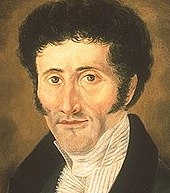Night pieces (Schumann)
The Night Pieces op. 23 are a piano cycle composed in 1839 by Robert Schumann . The title is derived from the stories of the same name by ETA Hoffmann , with which the four character pieces are in places emphasized monotonous through their gloomy atmosphere.
content
The first piece, a peculiarly monotonous march in C major ( more slow, often cautious ), is characterized by a rhythm that, similar to Gustav Mahler , often falters, therefore has nothing cheerfully decorative and despite the tone type it continues remembered a bizarre funeral march .
Even the first bar begins with ambiguity in harmony , the starting key is only reached for a brief moment in the third bar. Three differently dimensioned couplets develop and change the rhythm through ostinate figures, without ever completely displacing it.
The descent of the third , known from the Humoresque and Kreisleriana , determines the movement of the upper voices in even quarters in the first couplet from bar 9 , while in the second section (bars 25 to 38) it is an eighth movement in the tenor, which from bar 33 in the upper part is doubled. In the third, canonical arrangement from bars 49 to 73, Schumann takes the dynamics back down to the pianissimo. Only the last refrain with its splendid fortissimo episode corresponds to the common notions of a gloomy funeral march until the piece comes to a standstill again and fades away pianissimo via a ritardando movement.
The second composition in D minor ( marked and lively ), which is also quite uniform in terms of motifs, is reminiscent of a macabre cemetery vision with both capricious and contrapuntal elements.
A pianistic and sonically different world opens up in the effective third piece ( with great liveliness ) in D flat major , whose vigor and wild motor skills are reminiscent of the exuberant dance fantasies ( Davidsbündlertänze op. 6, Carnaval op. 9) of the previous piano cycles. The lively eighth note movements, initially played by the left hand and later also by the right hand, are interrupted by a grotesque Capriccio (bars 165-204) in F sharp minor , characterized by staccato quarters , followed by a coda .
The last piece ( ad libitum ), a simple round song, has something poetic about it. It ends the cycle with a melody somewhere between chorale and folk tones, which is interrupted by frequent pauses and played around by an arpeggio movement of the right hand that is reminiscent of a lute or guitar accompaniment . The melody is popular in English church chant under the name Canonbury and was also included in the Catholic hymn book Praise God in 2013 ( O God, thy will created the world , no. 628).
background
Schumann was familiar with Hoffmann's work and had read his Nachtstücks , with which the author followed up on his fantasy pieces in Callot's manner . In his new collection, however, Hoffmann emphasized less the ardent, enthusiastic magical power of romanticism , but underlined the uncanny and the cryptic, alluding to dark forces that are hidden in the depths of the soul.
Schumann's night pieces , which are linked by a similar motif , are among the last piano compositions begun in Vienna , along with the carnival period .
Schumann confided in his diary on March 31, 1839 that he had “written on a corpse fantasy”, mentioned “strange premonitions” and the farewell to his brother Eduard. If a letter from the previous day still appeared to him as “the harbinger” of his death, Eduard actually died on April 6, 1839. Schumann, who had not yet received the message on the following day, wrote in a letter to Clara when composing “ To have seen funeral trains, coffins, unhappy, desperate people ”.
The headlines he originally considered for the four pieces “Funeral Procession”, “Nocturnal Feast”, “Curious Society” and “Rundgesang mit Soloistimme” reveal the atmosphere of Hoffmann's stories, in which strange societies also meet, whose night feasts make the bizarre Let demonic break into everyday life.
Web links
- Night Pieces : Sheet Music and Audio Files in the International Music Score Library Project
Individual evidence
- ↑ Arnfried Edler : Works for piano for two hands until 1840. Night pieces op. 23. In: Ulrich Tadday (Ed.): Schumann-Handbuch. Metzler, Stuttgart et al. 2006, ISBN 3-476-01671-4 , p. 254.
- ^ Günther Batel: Nachteile. In: Günther Batel: Masterpieces of piano music. A guide through piano literature from its beginnings to the present. Approved special edition. Fourier, Wiesbaden 1997, ISBN 3-925037-93-4 , p. 328.
- ↑ Quoted from: Arnfried Edler: Works for piano for two hands until 1840. Night pieces op. 23. In: Ulrich Tadday (Ed.): Schumann-Handbuch. Metzler, Stuttgart et al. 2006, ISBN 3-476-01671-4 , p. 253

